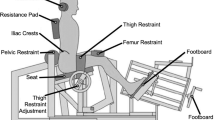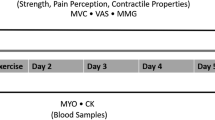Abstract
Purpose
The purpose of this study was to determine potential effects of isometric non-machine-based training on the cross-sectional area (CSA) of the paravertebral muscles in volunteers who were participants in a prevention program. An increase in the CSA of back muscles after various machine-based exercises have been reported but non-machine-based training programs have not been adressed before.
Materials and Methods
In the study 14 volunteers, who were participants of a company internal prevention program, underwent a magnetic resonance (MR) examination before and after a 3 months training program to improve back muscle strength. The MRI protocol consisted of T1-weighted and T2-weighted images aligned to the intervertebral disc spaces. The CSAs of the erector spinae and quadratus lumborum muscles were assessed twice by 2 operators at the levels L3/4, L4/5 and L5/S1.
Results
Out of 14 subjects 11 completed the training. The recorded CSA values exhibited an intrarater and intrarater correlation coefficient ranging from 0.949 to 0.989. There was an increase in CSA in all subjects after the training period (mean increase 8%).
Conclusions
A 3-month isometric training program is sufficient to effect measurable increases in back muscles volume. The study demonstrated the usefulness of MRI to quantify such changes as a measure of training efficacy and compliance into the training program. These results represent a rationale for further studies to determine the effect of different training methods on the CSA of back muscles and to correlate structural changes with clinical symptoms in chronic low back pain syndrome.




Similar content being viewed by others
References
Kamaz M, Kireşi D, Oğuz H, Emlik D, Levendoğlu F. CT measurement of trunk muscle areas in patients with chronic low back pain. Diagn Interv Radiol. 2007;13:144–8.
Hodges PW. The role of the motor system in spinal pain: implications for rehabilitation of the athlete following lower back pain. J Sci Med Sport. 2000;3:243–53.
Porterfield JA, DeRosa C. Mechanical low back pain: perspectives in functional anatomy. Philadelphia: Saunders, 1998. pp. 53–119.
Kay AG. An extensive literature review of the lumbar multifidus: anatomy. J Man Manip Ther. 2000;8:102–14.
Hubley-Kozey CL, Vezina MJ. Muscle activation during exercises to improve trunk stability in men with low back pain. Arch Phys Med Rehabil. 2002;83:1100–8.
Kader DF, Wardlaw D, Smith FW. Correlation between the MRI changes in the lumbar multifidus muscles and leg pain. Clin Radiol. 2000;55:145–9.
Rantanen J, Hurme M, Falck B, Alaranta H, Nykvist F, Lehto M et al. The lumbar multifidus muscle five years after surgery for a lumbar intervertebral disk herniation. Spine. 1993;18:568–74.
Sihvonen T, Herno A, Paljärvi L, Airaksinen O, Partanen J, Tapaninaho A. Local denervation atrophy of paraspinal muscles in postoperative failed back syndrome. Spine. 1993;18:575–81.
Mattila M, Hurme M, Alaranta H, Paljärvi L, Kalimo H, Falck B et al. The multifidus muscle in patients with lumbar disc herniation: a histochemical and morphometric analysis of intraoperative biopsies. Spine. 1986;11:732–8.
Campbell WW, Vasconcelos O, Laine FJ. Focal atrophy of the multifidus muscle in lumbosacral radiculopathy. Muscle Nerve. 1998;21:1350–3.
Dangaria TR, Naesh O. Changes in cross-sectional area of psoas major muscle in unilateral sciatica caused by herniation. Spine. 1998;15:928–31.
O’Sullivan PB, Phyty GD, Twomey LT, Allison GT. Evaluation of specific stabilizing exercise in the treatment of chronic low back pain with radiologic diagnosis of spondylolysis or spondylolisthesis. Spine. 1997;22:2959–67.
Yoshihara K, Shirai Y, Nakayama Y, Uesaka S. Histochemical changes in the multifidus muscle in patients with lumbar intervertebral disc herniation. Spine. 2001;26:622–6.
Parkkola R, Rytökoski U, Kurmano M. Magnetic resonance imaging of the discs and trunk muscles in patients with chronic low back pain healthy control subjects. Spine. 1993;18:830–6.
Hides J, Stokes MJ, Saide M, Jull GA, Cooper DH. Evidence of lumbar multifidus muscles wasting ipsilateral to symptoms in patients with acute/subacute low back pain. Spine. 1994;19:165–72.
Danneels LA, Vanderstraeten GG, Cambier DC, Witvrouw E, Bourgois J, Dankaerts W et al. Effects of three different training modalities on the cross sectional area of the lumbar multifidus muscle in patients with chronic low back pain. Br J Sports Med. 2001;35:186–91.
Barker KL, Shamley DR, Jackson D. Changes in the cross-sectional area of multifidus and psoas in patients with unilateral back pain. Spine. 2004;29:515–9.
Keller A, Brox JI, Gunderson R, Holm I, Friis A, Reikerås O. Trunk muscle strength, cross-sectional area, and density in patients with chronic low back pain randomized to lumbar fusion or cognitive intervention and exercises. Spine. 2004;29:3–8.
LeBlanc A, Lin C, Shackelford L, Sinitsyn V, Evans H, Belichenko O et al. Muscle volume, MRI relaxation times (T2), and body composition after spaceflight. J Appl Physiol. 2000;89:2158–64.
Carpenter DM, Nelson BW. Low back strengthening for the prevention and treatment of low back pain. Med Sci Sports Exerc. 1999;31:18–24.
Manniche C, Hesselsøe G, Bentzen L, Christensen I, Lundberg E. Clinical trial of intensive muscle training for chronic low back pain. Lancet. 1988;2:1473–6.
Neubauer E, Junge A, Pirron P, Seemann H, Schiltenwolf M. HKF-R 10—screening for predicting chronicity in acute low back pain (LBP): a prospective clinical trial. Eur J Pain. 2006;10:559–66.
Danneels La, Vanderstraeten GG, Cambier DC, Witvrouw E, De Cuyper H. CT imaging of trunk muscles in chronic low back pain patients and healthy control subjects. Eur Spine J. 2000;9:266–72.
Peltonen JE, Taimela S, Erkintalo M, Salminen JJ, Oksanen A, Kujala UM. Back extensor and psoas muscle cross-sectional area, prior physical training, and trunk muscle strength: a longitudinal study in adolescent girls. Eur J Appl Physiol. 1998;77:66–71.
Conflict of Interest Statement
The authors declare that there is no actual or potential conflict of interest in relation to this article.
Author information
Authors and Affiliations
Corresponding author
Rights and permissions
About this article
Cite this article
Lescher, S., Bender, B., Eifler, R. et al. Isometric Non-Machine-Based Prevention Training Program. Clin Neuroradiol 21, 217–222 (2011). https://doi.org/10.1007/s00062-011-0104-3
Received:
Accepted:
Published:
Issue Date:
DOI: https://doi.org/10.1007/s00062-011-0104-3




